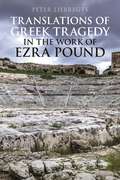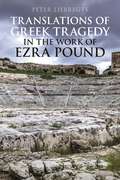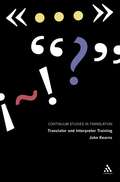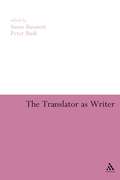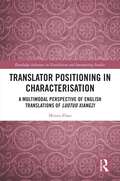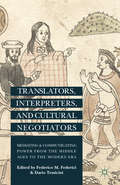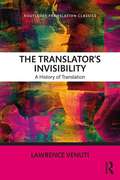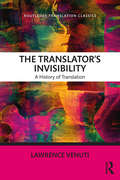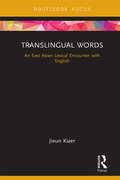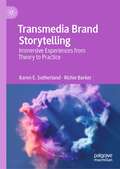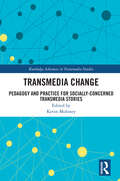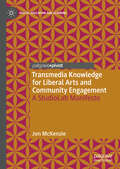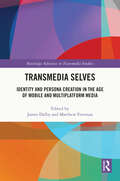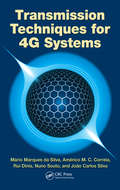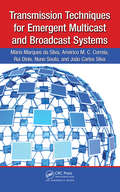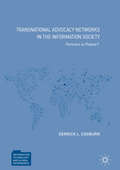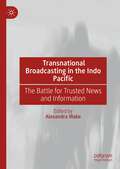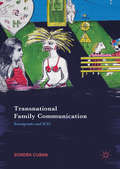- Table View
- List View
Translations of Greek Tragedy in the Work of Ezra Pound (Bloomsbury Studies in Classical Reception)
by Peter LiebregtsTurning the tables on the misconception that Ezra Pound knew little Greek, this volume looks at his work translating Greek tragedy and considers how influential this was for his later writing. Pound's work as a translator has had an enormous impact on the theory and practice of translation, and continues to be a source of heated debate. While scholars have assessed his translations from Chinese, Latin, and even Provençal, his work on Greek tragedy remains understudied. Pound's versions of Greek tragedy (of Aeschylus' Agamemnon, and of Sophocles' Elektra and Women of Trachis) have received scant attention, as it has been commonly assumed that Pound knew little of the language. Liebregts shows that the poet's knowledge of Greek was much more comprehensive than is generally assumed, and that his renderings were based on a careful reading of the source texts. He identifies the works Pound used as the basis for his translations, and contextualises his versions with regard to his biography and output, particularly The Cantos. A wealth of understudied source material is analysed, such as Pound's personal annotations in his Loeb edition of Sophocles, his unpublished correspondence with classical scholars such as F. R. Earp and Rudd Fleming, as well as manuscript versions and other as-yet-unpublished drafts and texts which illuminate his working methodology.
Translations of Greek Tragedy in the Work of Ezra Pound (Bloomsbury Studies in Classical Reception)
by Peter LiebregtsTurning the tables on the misconception that Ezra Pound knew little Greek, this volume looks at his work translating Greek tragedy and considers how influential this was for his later writing. Pound's work as a translator has had an enormous impact on the theory and practice of translation, and continues to be a source of heated debate. While scholars have assessed his translations from Chinese, Latin, and even Provençal, his work on Greek tragedy remains understudied. Pound's versions of Greek tragedy (of Aeschylus' Agamemnon, and of Sophocles' Elektra and Women of Trachis) have received scant attention, as it has been commonly assumed that Pound knew little of the language. Liebregts shows that the poet's knowledge of Greek was much more comprehensive than is generally assumed, and that his renderings were based on a careful reading of the source texts. He identifies the works Pound used as the basis for his translations, and contextualises his versions with regard to his biography and output, particularly The Cantos. A wealth of understudied source material is analysed, such as Pound's personal annotations in his Loeb edition of Sophocles, his unpublished correspondence with classical scholars such as F. R. Earp and Rudd Fleming, as well as manuscript versions and other as-yet-unpublished drafts and texts which illuminate his working methodology.
Translator and Interpreter Training: Issues, Methods and Debates (Continuum Studies in Translation)
by John KearnsAs a research area, education in the fields of translation and interpreting has received growing attention in recent years, with the increasing professionalization of the language-mediation sector demanding ever more highly trained employees with broader repertoires. This trend is evidenced in the present collection, which addresses issues in pedagogy in a variety of translation and interpreting domains. A global range of contributors discuss teaching, evaluation, professionalization and competence as they apply to an array of educational and linguistic situations. Translator and Interpreter Training: Issues, Methods and Debates presents an in-depth consideration of the issues involved in this area of translation and interpreting studies, and will be of interest to all students and academics working and researching in the field.
The Translator as Writer
by Susan Bassnett Peter BushOver the last two decades, interest in translation around the world has increased beyond any predictions. International bestseller lists now contain large numbers of translated works, and writers from Latin America, Africa, India and China have joined the lists of eminent, bestselling European writers and those from the global English-speaking world. Despite this, translators tend to be invisible, as are the processes they follow and the strategies they employ when translating. The Translator as Writer bridges the divide between those who study translation and those who produce translations, through essays written by well-known translators talking about their own work as distinctive creative literary practice. The book emphasises this creativity, arguing that translators are effectively writers, or rewriters who produce works that can be read and enjoyed by an entirely new audience. The aim of the book is to give a proper prominence to the role of translators and in so doing to move attention back to the act of translating, away from more abstract speculation about what translation might involve.
Translator Positioning in Characterisation: A Multimodal Perspective of English Translations of Luotuo Xiangzi (Routledge Advances in Translation and Interpreting Studies)
by Minru ZhaoApplying Systemic Functional Linguistics (SFL) to Descriptive Translation Studies (DTS), to three translations of a classic Chinese text, Zhao proposes a new model for linking translator positioning with translational norms in the target culture. Zhao combines the Appraisal model from SFL with a characterisation model to describe the role of translator positioning in character construction. Looking at three different translations of the classic Chinese novel Luotuo Xiangzi, she uses corpus tools to compare the opening and ending chapters of each translation, identifying textual patterns of translator positioning. She then analyses and compares the cover designs of the translated novels and reconstructs the translational norms governing the translator’s positioning in characterisation. In doing so she contributes to DTS by developing a systematic and consistent framework to analyse verbal and visual elements in translated novels. Her multimodal analysis also provides insights into the broader patterns of translated language. An insightful read for scholars interested in both theoretical and empirical approaches to translation studies.
Translator Positioning in Characterisation: A Multimodal Perspective of English Translations of Luotuo Xiangzi (Routledge Advances in Translation and Interpreting Studies)
by Minru ZhaoApplying Systemic Functional Linguistics (SFL) to Descriptive Translation Studies (DTS), to three translations of a classic Chinese text, Zhao proposes a new model for linking translator positioning with translational norms in the target culture. Zhao combines the Appraisal model from SFL with a characterisation model to describe the role of translator positioning in character construction. Looking at three different translations of the classic Chinese novel Luotuo Xiangzi, she uses corpus tools to compare the opening and ending chapters of each translation, identifying textual patterns of translator positioning. She then analyses and compares the cover designs of the translated novels and reconstructs the translational norms governing the translator’s positioning in characterisation. In doing so she contributes to DTS by developing a systematic and consistent framework to analyse verbal and visual elements in translated novels. Her multimodal analysis also provides insights into the broader patterns of translated language. An insightful read for scholars interested in both theoretical and empirical approaches to translation studies.
Translators, Interpreters, and Cultural Negotiators: Mediating and Communicating Power from the Middle Ages to the Modern Era
by Federico M. Federici Dario TessiciniHow do translators manage relations with parties in a position of authority and power? The book investigates the intellectual, social and professional identity of translators and interpreters across different time periods and locations when their role involves a negotiation with political powers and cultural authorities.
The Translator's Invisibility: A History of Translation (PDF)
by Lawrence VenutiSince publication over twenty years ago, The Translator’s Invisibility has provoked debate and controversy within the field of translation and become a classic text. Providing a fascinating account of the history of translation from the seventeenth century to the present day, Venuti shows how fluency prevailed over other translation strategies to shape the canon of foreign literatures in English and investigates the cultural consequences of the receptor values which were simultaneously inscribed and masked in foreign texts during this period. Reissued with a new introduction, in which the author provides a clear, detailed account of key concepts and arguments in order to issue a counterblast against simplistic interpretations, The Translator’s Invisibility takes its well-deserved place as part of the Routledge Translation Classics series. This book is essential reading for students of translation studies at all levels.
The Translator's Invisibility: A History of Translation (Routledge Translation Classics)
by Lawrence VenutiSince publication over twenty years ago, The Translator’s Invisibility has provoked debate and controversy within the field of translation and become a classic text. Providing a fascinating account of the history of translation from the seventeenth century to the present day, Venuti shows how fluency prevailed over other translation strategies to shape the canon of foreign literatures in English and investigates the cultural consequences of the receptor values which were simultaneously inscribed and masked in foreign texts during this period. Reissued with a new introduction, in which the author provides a clear, detailed account of key concepts and arguments in order to issue a counterblast against simplistic interpretations, The Translator’s Invisibility takes its well-deserved place as part of the Routledge Translation Classics series. This book is essential reading for students of translation studies at all levels.
The Translator's Invisibility: A History of Translation (Routledge Translation Classics)
by Lawrence VenutiSince publication over twenty years ago, The Translator’s Invisibility has provoked debate and controversy within the field of translation and become a classic text. Providing a fascinating account of the history of translation from the seventeenth century to the present day, Venuti shows how fluency prevailed over other translation strategies to shape the canon of foreign literatures in English and investigates the cultural consequences of the receptor values which were simultaneously inscribed and masked in foreign texts during this period. Reissued with a new introduction, in which the author provides a clear, detailed account of key concepts and arguments in order to issue a counterblast against simplistic interpretations, The Translator’s Invisibility takes its well-deserved place as part of the Routledge Translation Classics series. This book is essential reading for students of translation studies at all levels.
Translingual Words: An East Asian Lexical Encounter with English
by Jieun KiaerTranslingual Words is a detailed case study on lexical integration, or mediation, occurring between East Asian languages and English(es). In Part I, specific examples from global linguistic corpora are used to discuss the issues involved in lexical interaction between East Asia and the English-speaking world. Part II explores the spread of East Asian words in English, while Part III discusses English words which can be found in East Asian languages. Translingual Words presents a novel approach on hybrid words by challenging the orthodox ideas on lexical borrowing and explaining the dynamic growth of new words based on translingualism and transculturalism.
Translingual Words: An East Asian Lexical Encounter with English
by Jieun KiaerTranslingual Words is a detailed case study on lexical integration, or mediation, occurring between East Asian languages and English(es). In Part I, specific examples from global linguistic corpora are used to discuss the issues involved in lexical interaction between East Asia and the English-speaking world. Part II explores the spread of East Asian words in English, while Part III discusses English words which can be found in East Asian languages. Translingual Words presents a novel approach on hybrid words by challenging the orthodox ideas on lexical borrowing and explaining the dynamic growth of new words based on translingualism and transculturalism.
Transmedia Brand Storytelling: Immersive Experiences from Theory to Practice
by Karen E. Sutherland Richie BarkerThis book presents new global research on transmedia storytelling as a form of brand communication. It explores the theoretical underpinnings of transmedia storytelling and its practical application through survey and interview data from creatives, marketing, advertising and public relations practitioners. The final section analyzes contemporary campaigns from various countries and proposes a Transmedia Brand Storytelling Model for Practice, based on primary and secondary research data. The book aims to better understand and communicate the real-world opportunities and barriers to producing transmedia brand storytelling campaigns for practitioners.
Transmedia Change: Pedagogy and Practice for Socially-Concerned Transmedia Stories (Routledge Advances in Transmedia Studies)
by Kevin MoloneyThis book examines and illustrates the use of design principles, design thinking, and other empathy research techniques in university and public settings, to plan and ethically target socially-concerned transmedia stories and evaluate their success through user experience testing methods. All media industries continue to adjust to a dispersed, diverse, and dilettante mediascape where reaching a large global audience may be easy but communicating with a decisive and engaged public is more difficult. This challenge is arguably toughest for communicators who work to engage a public with reality rather than escape. The chapters in this volume outline the pedagogy and practice of design, empathy research methods for story development, transmedia logics for socially-concerned stories, development of community engagement and the embrace of collective narrative, art and science research collaboration, the role of mixed and virtual reality in prosocial communication, ethical audience targeting, and user experience testing for storytelling campaigns. Each broad topic includes case examples and full case studies of each stage in production. Offering a detailed exploration of a fast-emerging area, this book will be of great relevance to researchers and university teachers of socially-concerned transmedia storytelling in fields such as journalism, documentary filmmaking, education, and activism.
Transmedia Change: Pedagogy and Practice for Socially-Concerned Transmedia Stories (Routledge Advances in Transmedia Studies)
by Kevin MoloneyThis book examines and illustrates the use of design principles, design thinking, and other empathy research techniques in university and public settings, to plan and ethically target socially-concerned transmedia stories and evaluate their success through user experience testing methods. All media industries continue to adjust to a dispersed, diverse, and dilettante mediascape where reaching a large global audience may be easy but communicating with a decisive and engaged public is more difficult. This challenge is arguably toughest for communicators who work to engage a public with reality rather than escape. The chapters in this volume outline the pedagogy and practice of design, empathy research methods for story development, transmedia logics for socially-concerned stories, development of community engagement and the embrace of collective narrative, art and science research collaboration, the role of mixed and virtual reality in prosocial communication, ethical audience targeting, and user experience testing for storytelling campaigns. Each broad topic includes case examples and full case studies of each stage in production. Offering a detailed exploration of a fast-emerging area, this book will be of great relevance to researchers and university teachers of socially-concerned transmedia storytelling in fields such as journalism, documentary filmmaking, education, and activism.
Transmedia Knowledge for Liberal Arts and Community Engagement: A StudioLab Manifesto (Digital Education and Learning)
by Jon McKenzieThis book sets forth a pedagogy for renewing the liberal arts by combining critical thinking, media activism, and design thinking. Using the StudioLab approach, the author seeks to democratize the social and technical practices of digital culture just as nineteenth century education sought to democratize literacy. This production of transmedia knowledge—from texts and videos to comics and installations—moves students between seminar, studio, lab, and field activities. The book also wrestles with the figure of Plato and the very medium of knowledge to re-envision higher education in contemporary societies, issuing a call for community engagement as a form of collective thought-action.
Transmedia Selves: Identity and Persona Creation in the Age of Mobile and Multiplatform Media (Routledge Advances in Transmedia Studies)
by James Dalby Matthew FreemanThis book examines the mediated shift in the contemporary human condition, focusing on the ways in which we synthesise with media content in daily life, essentially transmediating ourselves into new forms and (re)creating ourselves across media. Across an international roster of essays, this book establishes a transdisciplinary theory for the ‘transmedia self’, exploring how technological ubiquity and digital self-determination combine with themes and disciplines such as celebrity culture, fandom, play, politics, and ultimately broader self-conception and projection to inform the creation of transmedia identities in the twenty-first century. Specifically, the book repositions transmediality as key to understanding the formation of identity in a post-digital media culture and transmedia age, where our lives are interlaced, intermingled, and narrativised across a range of media platforms and interfaces. This book is ideal for scholars and students interested in transmedia storytelling, cultural studies, media studies, sociology, philosophy, and politics.
Transmedia Selves: Identity and Persona Creation in the Age of Mobile and Multiplatform Media (Routledge Advances in Transmedia Studies)
This book examines the mediated shift in the contemporary human condition, focusing on the ways in which we synthesise with media content in daily life, essentially transmediating ourselves into new forms and (re)creating ourselves across media. Across an international roster of essays, this book establishes a transdisciplinary theory for the ‘transmedia self’, exploring how technological ubiquity and digital self-determination combine with themes and disciplines such as celebrity culture, fandom, play, politics, and ultimately broader self-conception and projection to inform the creation of transmedia identities in the twenty-first century. Specifically, the book repositions transmediality as key to understanding the formation of identity in a post-digital media culture and transmedia age, where our lives are interlaced, intermingled, and narrativised across a range of media platforms and interfaces. This book is ideal for scholars and students interested in transmedia storytelling, cultural studies, media studies, sociology, philosophy, and politics.
Transmission Medium (tactile)
by RnibThis diagram shows a high speed medium. 4 routers are linked in an elipse. The line connecting them is labelled as a high-speed backbone. A hub is joined onto the bottom router and has 3 pcs coming from it. The links from pc to hub are labelled ethernet.
Transmission Techniques for 4G Systems
by Mario Marques da Silva Americo Correia Rui Dinis Nuno Souto Joao Carlos SilvaFourth Generation (4G) wireless communication systems support current and emergent multimedia services such as mobile TV, social networks and gaming, high-definition TV, video teleconferencing, and messaging services. These systems feature the All-over-IP concept and boast improved quality of service. Several important R&D activities are curren
Transmission Techniques for 4G Systems
by Mario Marques da Silva Americo Correia Rui Dinis Nuno Souto Joao Carlos SilvaFourth Generation (4G) wireless communication systems support current and emergent multimedia services such as mobile TV, social networks and gaming, high-definition TV, video teleconferencing, and messaging services. These systems feature the All-over-IP concept and boast improved quality of service. Several important R&D activities are curren
Transmission Techniques for Emergent Multicast and Broadcast Systems
by Mario Marques da Silva Americo Correia Rui Dinis Nuno Souto Joao Carlos SilvaDescribing efficient transmission schemes for broadband wireless systems, Transmission Techniques for Emergent Multicast and Broadcast Systems examines advances in transmission techniques and receiver designs capable of supporting the emergent wireless needs for multimedia broadcast and multicast service (MBMS) requirements. It summarizes the resea
Transnational Advocacy Networks in the Information Society: Partners or Pawns? (Information Technology and Global Governance)
by Derrick L. CogburnThis book examines the role of transnational advocacy networks in enabling effective participation for individual citizens in the deliberative processes of global governance. Contextualized around the international conference setting of the United Nations-sponsored World Summit on the Information Society (WSIS) in 2003 and 2005, the book sees epistemic communities and information and communication technologies (ICTs) as critical to the effectiveness of this important organizational form. Historically, governments have dominated the official “conference diplomacy” surrounding these World Summits. However, reflecting the UN General Assembly resolution authorizing WSIS, transnational civil society and private sector organizations were invited to participate as official partners in a multistakeholder dialogue at the summit alongside the more traditional governments and international organizations. This book asks: are transnational advocacy networks active in the global information society influential partners in these global governance processes, or merely symbolic tokens—or pawns? Cogburn explores the factors that enabled some networks—such as the Internet Governance Caucus—to persist and thrive, while others failed, and sees linkages with epistemic communities—such as the Global Internet Governance Academic Network—and ICTs as critical to network effectiveness.
Transnational Broadcasting in the Indo Pacific: The Battle for Trusted News and Information
by Alexandra WakeTransnational Broadcasting in the Indo-Pacific brings together research spanning journalism, broadcast and political science to interrogate the issues arising from a rapidly changing global political and broadcast environment. This book asks: Why is there increasing interest in the provision of English-language media in the Indo-Pacific from countries like China? What are the implications for the traditional providers of foreign-produced news such as the Australia Broadcasting Corporation and the British Broadcasting Corporation? What now is the role of social media in the creation of broadcast journalism, and why is there panic in diplomatic circles about some of the journalism that originates from broadcasters in China and Russia? The result is a book that offers an insight into a rapidly transforming media landscape, the changing state of international relations, and the rise of new powers.
Transnational Family Communication: Immigrants and ICTs
by Sondra CubanThis book explores the struggles that immigrant women experience when communicating with their transnational families through information and communication technologies (ICTs). Sondra Cuban recounts the fascinating stories of sixty female immigrants living in Washington state, and explores how gender, social class, nationality, and language influence their ICT usage. She addresses the emotional labor involved in interacting with the families they left behind as well as their ingenious communication systems which challenge the existing research surrounding this unique phenomenon. Early chapters of this book detail the current arguments and theories of transnational family communication in order to propose a new model thereof. Throughout, larger questions of global equality are addressed.
